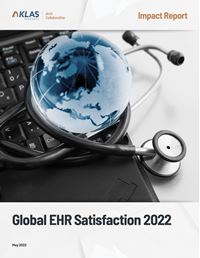Global EHR Satisfaction 2022
In 2019, KLAS published early findings on EHR satisfaction outside the United States. Since then, additional non-US organizations have participated in Arch Collaborative measurement, revealing new insights on the state of EHR satisfaction around the globe. Based on 28 Collaborative measurements from 23 health systems in Asia/Oceania, Europe, and the Middle East, this report seeks to help healthcare organizations in regions outside the US better understand the factors that contribute to clinician satisfaction with the EHR. On average, clinicians in the Middle East report the highest EHR satisfaction, but there are highly satisfied users in each global region, and we can learn helpful information from each.
Want to see full details?
Want to see full details?
Here is my information:

Note: Each individual clinician’s responses to the Arch Collaborative EHR Experience Survey regarding core factors such as the EHR’s efficiency, functionality, impact on care, and so on are aggregated into an overall Net EHR Experience Score (NEES), which represents a snapshot of the clinician’s overall satisfaction with the EHR environment at their organization. The NEES is calculated by subtracting the percent of negative user feedback from the percent of positive user feedback. An NEES can range from -100 (all negative feedback) to 100 (all positive feedback).
Note: For simplicity, the term “global” will be used throughout the report to refer to the healthcare organizations and clinicians whose feedback is being analyzed in this study.
Trust in IT & Organization Leadership Is Crucial to EHR Satisfaction
Across Collaborative members and regardless of geographic location, Collaborative data has shown that a supportive IT structure is the factor most associated with strong EHR satisfaction. Specifically at global health systems, clinicians who strongly agree that their organization supports the EHR well are 132 times more likely to be satisfied with the EHR than those who strongly disagree. Those who disagree or strongly disagree that their organization provides sufficient support for the EHR account for 26% of all respondents from global health systems.


Organizations that have lower levels of trust between clinicians and organization and IT leadership may wonder what they can do to improve. King Faisal Specialist Hospital & Research Centre in Saudi Arabia hosted a Collaborative webinar in which they shared how they create a high-trust environment by supporting their end users and engaging clinicians in EHR governance. Key points from the webinar include:
- Engage clinical participants in EHR governance
- Deploy superusers or clinician champions who share the same clinical background as end users and can pass challenges experienced by users and ideas for enhancement on to governance committees
- Include representation from all departments on the clinician informatics team
- Standardize new-hire education; use ongoing EHR education to focus on training specific to the end user’s specialty and needs
- Engage end users in creating EHR education
- Analyze end-user feedback and present it to leadership to gain buy-in, then act on the areas needing improvement
EHR Training Represents Significant Opportunity for Global Health Systems

- Self-directed eLearning is not as effective as other types of training
- Clinician satisfaction with training is higher when the training lasts at least an hour
- On average, clinicians who strongly agree that their initial or ongoing EHR training prepared them well to use the system have Net EHR Experience Scores significantly higher than clinicians who strongly disagree that their training was sufficient



Clinician Burnout Is a Global Issue
26% of clinicians in this global research report at least some symptoms of burnout. Compared to other clinical roles, nurses and allied health professionals are the most likely to be experiencing burnout and may need extra consideration as organizations look for opportunities to address the challenges that drive burnout.


- Ongoing training: Clinicians who strongly disagree that their ongoing training is sufficient are 3.5 times more likely to report feeling burned out.
- Trust in organization/IT leadership: Clinicians who report strong trust in their organization leadership and IT are 14% less likely to report feeling burned out.
- Charting efficiency: Burnout can be significantly impacted by the amount of time a clinician spends charting. Globally, clinicians with a highly efficient chart-closure rate (i.e., they complete >66% of charts the same day) are less likely to report burnout (see chart). Efficient charting also leads to higher EHR satisfaction in both inpatient and outpatient environments. Global organizations may benefit from reviewing the Collaborative report on Immediate Chart-Closure Rates for best practices around charting efficiency.
What Is the KLAS Arch Collaborative?
The Arch Collaborative is a group of healthcare organizations committed to improving the EHR experience through standardized surveys and benchmarking. To date, over 250 healthcare organizations have surveyed their end users and over 240,000 clinicians have responded. Impact reports such as this one seek to synthesize the feedback from these clinicians into actionable insights that organizations can use to revolutionize patient care by unlocking the potential of the EHR. To participate in the Arch Collaborative, go to klasresearch.com/arch-collaborative.
Report Non-Public HTML Body
Report Public HTML Body
Topics
Report Topics
Clinician Efficiency and Personalization, Clinician Relationships and Communication, Clinician Wellness and Reducing BurnoutThis material is copyrighted. Any organization gaining unauthorized access to this report will be liable to compensate KLAS for the full retail price. Please see the KLAS DATA USE POLICY for information regarding use of this report. © 2019 KLAS Research, LLC. All Rights Reserved. NOTE: Performance scores may change significantly when including newly interviewed provider organizations, especially when added to a smaller sample size like in emerging markets with a small number of live clients. The findings presented are not meant to be conclusive data for an entire client base.



